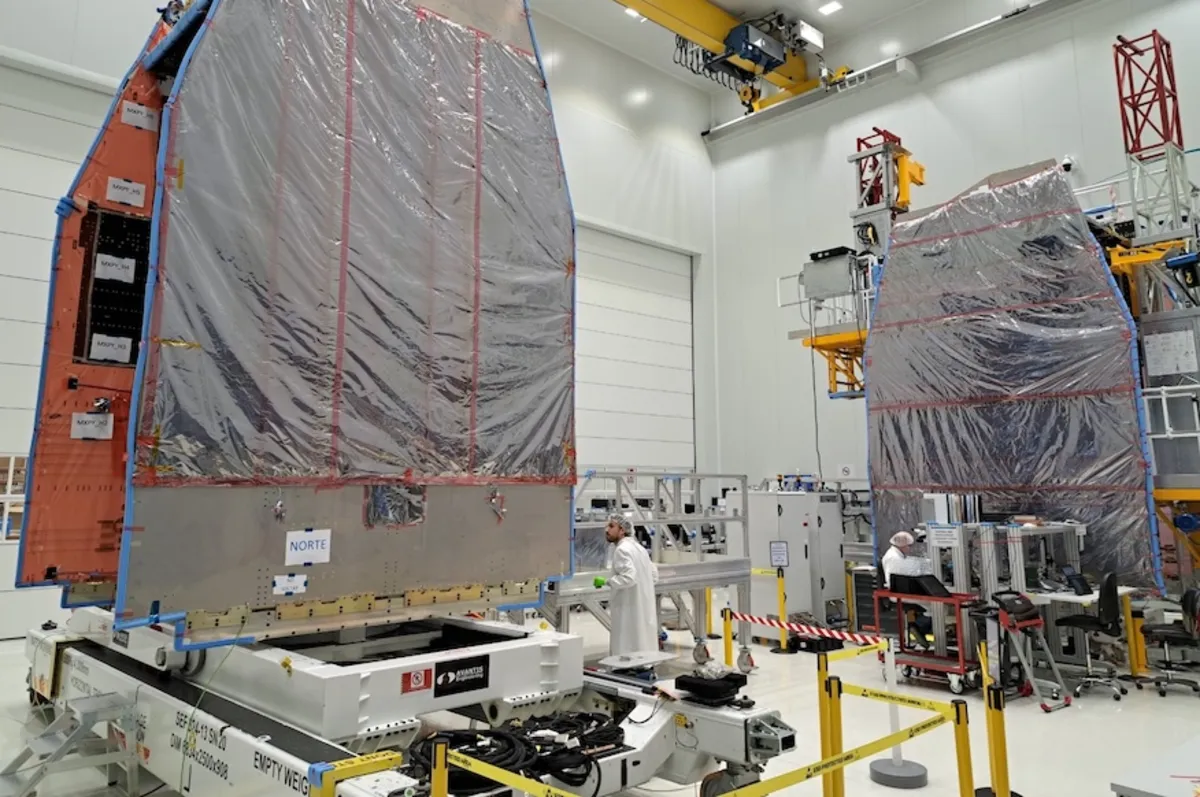
On Thursday, a SpaceX Falcon 9 first stage is set to embark on its 21st and final mission, marking a significant milestone for the company’s innovative reusable rocket program. This rare expendable mission will launch a crucial communications satellite, the SpainSat NG 2, for the nation of Spain. Originally scheduled for Wednesday night, the launch has been postponed by 24 hours, although SpaceX has not disclosed the reasons for this delay.
On Wednesday morning, the Falcon 9 rocket was spotted at the launch pad but was later returned to its assembly hangar before rolling out again for the launch. Notably, the Falcon 9 first-stage booster will not be recovered during this mission due to the additional performance required to deliver the payload to orbit. To maximize efficiency, the rocket will not be equipped with landing legs or grid fins, which are typically used for recovery. This strategic decision will enhance the rocket's lift capacity by reducing weight.
The two halves of the payload fairing are expected to be recovered after their descent into the Atlantic Ocean, ensuring that valuable components can be reused in future missions. The SpainSat NG 2 satellite, with a fully fueled mass of 6.1 tons (13,448 lbs.), is set to be deployed into a geosynchronous transfer orbit approximately 35 minutes after liftoff. Following its deployment, the satellite will perform maneuvers to position itself into geostationary orbit.
The launch is scheduled to take place from Space Launch Complex 40 at Cape Canaveral Space Force Station during a four-hour window that opens at 9:30 p.m. EDT (0130 UTC). Spaceflight Now will offer live coverage starting approximately one hour before the scheduled liftoff. The 45th Weather Squadron has indicated a greater than 95 percent chance of favorable weather conditions during the launch window, with no specific meteorological concerns reported.
If there are no further delays beyond Thursday, this launch will mark the 134th orbital launch of 2025 for SpaceX, matching the total number of launches achieved by the company in all of 2024. SpaceX aims to surpass 170 launches this year, showcasing its commitment to expanding its launch capabilities.
The SpainSat NG 2 satellite is the second in a series of two geostationary satellites managed by Hisdesat, a Spanish company. Its predecessor, the SpainSat NG 1, was launched on January 29, 2025, aboard another Falcon 9 rocket, and began operations at the 30 degrees West position on August 11. In contrast, the SpainSat NG 2 will operate at 29 degrees East, both satellites designed to have a nominal operating life of 15 years.
Built on the Eurostar Neo satellite bus developed by Airbus Defence and Space, both satellites have an impressive wingspan of nearly 50 meters (164 ft.). Funding for the SpainSat NG 2 project was partially provided by a €74 million ($86 million) investment from Spain's Ministry of Science, Innovation and Universities through the Agencia Espacial Española (Spanish Space Agency) and the Centro para el Desarrollo Tecnológica y la Innovación (Center for Technological Development and Innovation).
As stated by the Minister of Science, Innovation and Universities, Diana Morant, "This satellite will place the Spanish industry at the top of Europe in the field of advanced secure communication systems." She emphasized that it represents the most innovative and advanced communications satellite in Europe, exemplifying the Ministry's commitment to development, progress, and innovation.
The primary function of the SpainSat NG 2 satellite is to provide secure communications for the Government of Spain. Additionally, Hisdesat will extend its functionality to the European Union via the Govsatcom program and NATO. Operating in the X-, Ka-, and UHF-bands, the satellites deliver extensive coverage, reaching from the United States in North America to Singapore in Asia. Airbus is responsible for the X-band payload, while Thales Alenia Space's Spanish office constructed the Military Ka- and UHF-band payloads, enhancing the satellite's capabilities in secure communications.